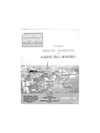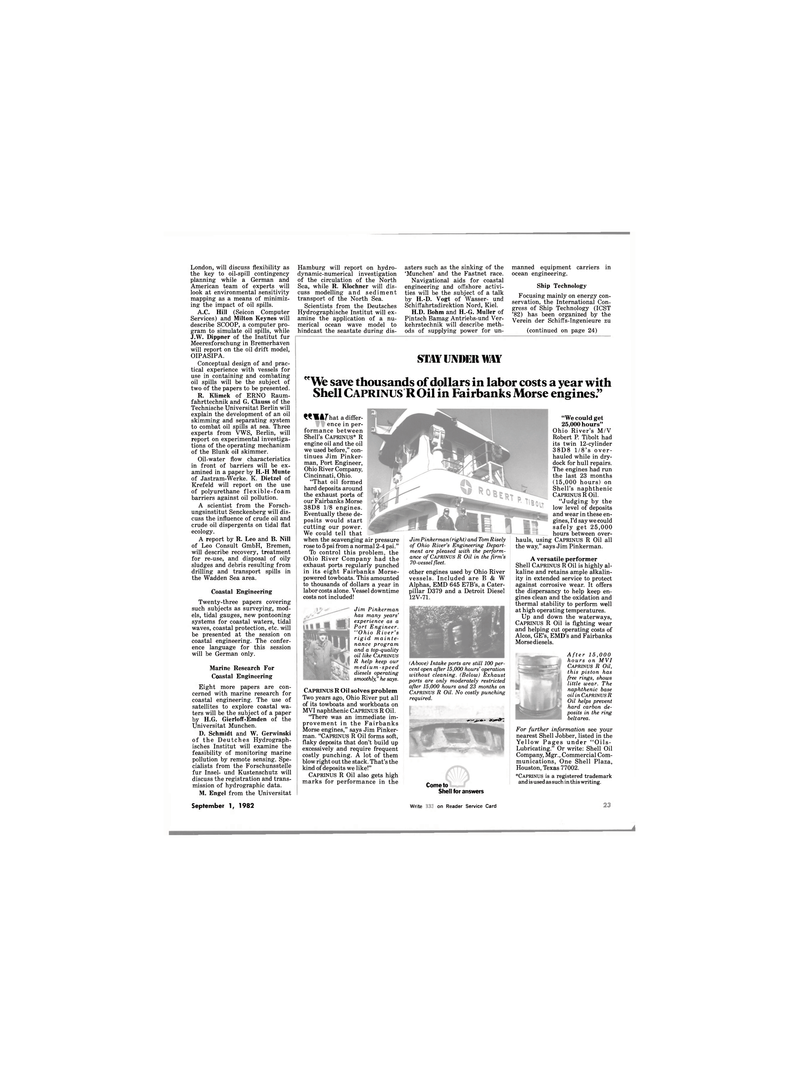
Page 19: of Maritime Reporter Magazine (September 1982)
Read this page in Pdf, Flash or Html5 edition of September 1982 Maritime Reporter Magazine
London, will discuss flexibility as the key to oil-spill contingency planning while a German and
American team of experts will look at environmental sensitivity mapping as a means of minimiz- ing the impact of oil spills.
A.C. Hill (Seicon Computer
Services) and Milton Keynes will describe SCOOP, a computer pro- gram to simulate oil spills, while
J.W. Dippner of the Institut fur
Meeresforschung in Bremerhaven will report on the oil drift model,
OIPASIPA.
Conceptual design of and prac- tical experience with vessels for use in containing and combating oil spills will be the subject of two of the papers to be presented.
R. Klimek of ERNO Raum- fahrttechnik and G. Clauss of the
Technische Universitat Berlin will explain the development of an oil skimming and separating system to combat oil spills at sea. Three experts from VWS, Berlin, will report on experimental investiga- tions of the operating mechanism of the Blunk oil skimmer.
Oil-water flow characteristics in front of barriers will be ex- amined in a paper by H.-H Munte of Jastram-Werke. K. Dietzel of
Krefeld will report on the use of polyurethane flexible-foam barriers against oil pollution.
A scientist from the Forsch- ungsinstitut Senckenberg will dis- cuss the influence of crude oil and crude oil dispergents on tidal flat ecology.
A report by R. Leo and B. Nill of Leo Consult GmbH, Bremen, will describe recovery, treatment for re-use, and disposal of oily sludges and debris resulting from drilling and transport spills in the Wadden Sea area.
Coastal Engineering
Twenty-three papers covering such subjects as surveying, mod- els, tidal gauges, new pontooning systems for coastal waters, tidal waves, coastal protection, etc. will be presented at the session on coastal engineering. The confer- ence language for this session will be German only.
Marine Research For
Coastal Engineering
Eight more papers are con- cerned with marine research for coastal engineering. The use of satellites to explore coastal wa- ters will be the subject of a paper by H.G. Gierloff-Emden of the
Universitat Munchen.
D. Schmidt and W. Gerwinski of the Deutches Hydrograph- isches Institut will examine the feasibility of monitoring marine pollution by remote sensing. Spe- cialists from the Forschunsstelle fur Insel- und Kustenschutz will discuss the registration and trans- mission of hydrographic data.
M. Engel from the Universitat
Hamburg will report on hydro- dynamic-numerical investigation of the circulation of the North
Sea, while R. Klochner will dis- cuss modelling and sediment transport of the North Sea.
Scientists from the Deutsches
Hydrographische Institut will ex- amine the application of a nu- merical ocean wave model to hindcast the seastate during dis- asters such as the sinking of the 'Munchen' and the Fastnet race.
Navigational aids for coastal engineering and offshore activi- ties will be the subject of a talk by H.-D. Vogt of Wasser- und
Schiffahrtsdirektion Nord, Kiel.
H.D. Bohm and H.-G. Muller of
Pintsch Bamag Antriebs-und Ver- kehrstechnik will describe meth- ods of supplying power for un- manned equipment carriers in ocean engineering.
Ship Technology
Focusing mainly on energy con- servation, the International Con- gress of Ship Technology (ICST '82) has been organized by the
Verein der Schiffs-Ingenieure zu (continued on page 24)
STAY UNDER WAY "We save thousands of dollars in labor costs a year with Shell CAPRINUS ROil in Fairbanks Morse engines." «¥4fhat a differ- ence in per- formance between
Shell's CAPRINUS* R engine oil and the oil we used before," con- tinues Jim Pinker- man, Port Engineer,
Ohio River Company,
Cincinnati, Ohio. "That oil formed hard deposits around the exhaust ports of our Fairbanks Morse 38D8 1/8 engines.
Eventually these de- posits would start cutting our power.
We could tell that when the scavenging air pressure rose to 5 psi from a normal 2-4 psi."
To control this problem, the
Ohio River Company had the exhaust ports regularly punched in its eight Fairbanks Morse- powered towboats. This amounted to thousands of dollars a year in labor costs alone. Vessel downtime costs not included!
Jim Pinkerman (right) and Tom R isely of Ohio River's Engineering Depart- ment are pleased with the perform- ance of CAPRINUS R Oil in the firm's 70-vessel fleet. other engines used by Ohio River vessels. Included are B & W
Alphas, EMD 645 E7B's, a Cater- pillar D379 and a Detroit Diesel 12V-71. "We could get 25,000 hours"
Ohio River's M/V
Robert P. Tibolt had its twin 12-cylinder 38D8 1/8's over- hauled while in dry- dock for hull repairs.
The engines had run the last 23 months (15,000 hours) on
Shell's naphthenic
CAPRINUS R Oil. "Judging by the low level of deposits and wear in these en- gines, I'd say we could safely get 25,000 hours between over- hauls, using CAPRINUS R Oil all the way," says Jim Pinkerman.
A versatile performer
Shell CAPRINUS R Oil is highly al- kaline and retains ample alkalin- ity in extended service to protect against corrosive wear. It offers the dispersancy to help keep en- gines clean and the oxidation and thermal stability to perform well at high operating temperatures.
Up and down the waterways,
CAPRINUS R Oil is fighting wear and helping cut operating costs of
Alcos, GE's, EMD's and Fairbanks
Morse diesels.
For further information see your nearest Shell Jobber, listed in the
Yellow Pages under "Oils-
Lubricating." Or write: Shell Oil
Company, Mgr., Commercial Com- munications, One Shell Plaza,
Houston, Texas 77002. *CAPRINUS is a registered trademark and is used as such in this writing. (Above) Intake ports are still 100 per- cent open after 15,000 hours' operation without cleaning. (Below) Exhaust ports are only moderately restricted after 15,000 hours and 23 months on
CAPRINUS R Oil. No costly punching required. wgew^MMy
Come to
Shell for answers
After 15,000 hours on MVI
CAPRINUS R Oil, this piston has free rings, shows little wear. The naphthenic base oil in CAPRINUS R
Oil helps prevent hard carbon de- posits in the ring belt area.
Jim Pinkerman has many years' experience as a
Port Engineer. "Ohio River's rigid mainte- nance program and a top-quality oil like CAPRINUS
R help keep our medium-speed diesels operating smoothly," he says.
CAPRINUS R Oil solves problem
Two years ago, Ohio River put all of its towboats and workboats on
MVI naphthenic CAPRINUS R Oil. "There was an immediate im- provement in the Fairbanks
Morse engines," says Jim Pinker- man. "CAPRINUS R Oil forms soft, flaky deposits that don't build up excessively and require frequent costly punching. A lot of them blow right out the stack. That's the kind of deposits we like!"
CAPRINUS R Oil also gets high marks for performance in the
September 1, 1982 Write 650 on Reader Service Card 21

 18
18

 20
20
